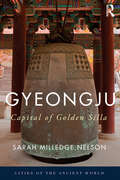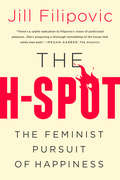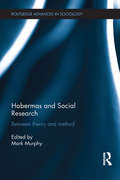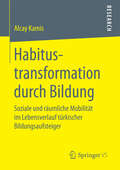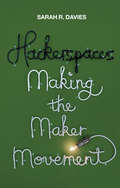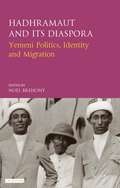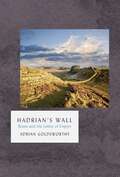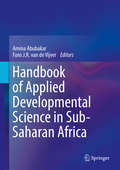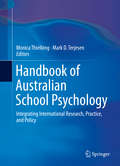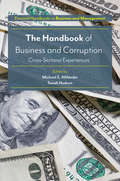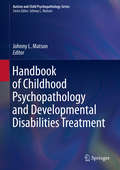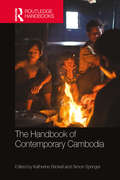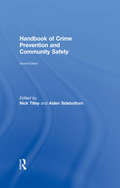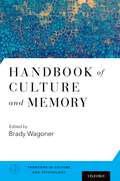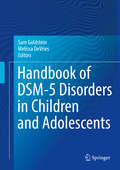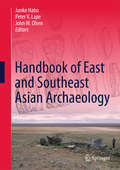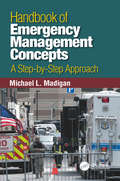- Table View
- List View
Gyeongju: The Capital of Golden Silla (Cities of the Ancient World)
by Sarah Milledge NelsonGyeongju, the capital of the Kingdom of Silla, grew from a loose confederation of villages, called Saro, to become the capital of most of the Korean peninsula. Its relationships with Japan, the Eurasian Steppes, and countries along the Silk Road leading to Europe helped to make the city one of the most prosperous and significant in ancient East Asia. In this seminal new volume, Sarah Milledge Nelson draws on over 30 years’ experience to offer the first complete history of this fascinating city. Gyeongju explores culture, class and rank, industry, international relations, rulers, and socio-cultural issues such as gender, and examines in detail the complex systems of class and rank, Gyeongju’s position as the royal seat of Silla, and the influence and legacy of the ancient city. Excavations in Gyeongju have provided evidence not only of the wealth and power of the monarchy, but also of production and agriculture, and the reach of Gyeongju’s trade routes, making this city a fascinating case study for the region. Augmented with extensive maps and images which illustrate the city’s rich history, this volume is crucial reading for anyone interested in the city, the kingdom of Silla, the history and archaeology of Korea, and early urbanism and state formation in East Asia.
Gyeongju: The Capital of Golden Silla (Cities of the Ancient World)
by Sarah Milledge NelsonGyeongju, the capital of the Kingdom of Silla, grew from a loose confederation of villages, called Saro, to become the capital of most of the Korean peninsula. Its relationships with Japan, the Eurasian Steppes, and countries along the Silk Road leading to Europe helped to make the city one of the most prosperous and significant in ancient East Asia. In this seminal new volume, Sarah Milledge Nelson draws on over 30 years’ experience to offer the first complete history of this fascinating city. Gyeongju explores culture, class and rank, industry, international relations, rulers, and socio-cultural issues such as gender, and examines in detail the complex systems of class and rank, Gyeongju’s position as the royal seat of Silla, and the influence and legacy of the ancient city. Excavations in Gyeongju have provided evidence not only of the wealth and power of the monarchy, but also of production and agriculture, and the reach of Gyeongju’s trade routes, making this city a fascinating case study for the region. Augmented with extensive maps and images which illustrate the city’s rich history, this volume is crucial reading for anyone interested in the city, the kingdom of Silla, the history and archaeology of Korea, and early urbanism and state formation in East Asia.
The H-Spot: The Feminist Pursuit of Happiness
by Jill FilipovicWhat do women want? The same thing men were promised in the Declaration of Independence: happiness, or at least the freedom to pursue it. For women, though, pursuing happiness is a complicated endeavor, and if you head out into America and talk to women one-on-one, as Jill Filipovic has done, you'll see that happiness is indelibly shaped by the constraints of gender, the expectations of feminine sacrifice, and the myriad ways that womanhood itself differs along lines of race, class, location, and identity. In The H-Spot, Filipovic argues that the main obstacle standing in-between women and happiness is a rigged system. In this world of unfinished feminism, men have long been able to "have it all" because of free female labor, while the bar of achievement for women has only gotten higher. Never before have women at every economic level had to work so much (whether it's to be an accomplished white-collar employee or just make ends meet). Never before have the standards of feminine perfection been so high. And never before have the requirements for being a "good mother" been so extreme. If our laws and policies made women's happiness and fulfillment a goal in and of itself, Filipovic contends, many of our country's most contentious political issues--from reproductive rights to equal pay to welfare spending--would swiftly be resolved. Filipovic argues that it is more important than ever to prioritize women's happiness-and that doing so will make men's lives better, too. Here, she provides an outline for a feminist movement we all need and a blueprint for how policy, laws, and society can deliver on the promise of the pursuit of happiness for all.
The H-Spot: The Feminist Pursuit of Happiness
by Jill FilipovicWhat do women want? The same thing men were promised in the Declaration of Independence: happiness, or at least the freedom to pursue it. For women, though, pursuing happiness is a complicated endeavor, and if you head out into America and talk to women one-on-one, as Jill Filipovic has done, you'll see that happiness is indelibly shaped by the constraints of gender, the expectations of feminine sacrifice, and the myriad ways that womanhood itself differs along lines of race, class, location, and identity. In The H-Spot, Filipovic argues that the main obstacle standing in-between women and happiness is a rigged system. In this world of unfinished feminism, men have long been able to "have it all" because of free female labor, while the bar of achievement for women has only gotten higher. Never before have women at every economic level had to work so much (whether it's to be an accomplished white-collar employee or just make ends meet). Never before have the standards of feminine perfection been so high. And never before have the requirements for being a "good mother" been so extreme. If our laws and policies made women's happiness and fulfillment a goal in and of itself, Filipovic contends, many of our country's most contentious political issues -- from reproductive rights to equal pay to welfare spending -- would swiftly be resolved. Filipovic argues that it is more important than ever to prioritize women's happiness-and that doing so will make men's lives better, too. Here, she provides an outline for a feminist movement we all need and a blueprint for how policy, laws, and society can deliver on the promise of the pursuit of happiness for all.
Habermas and Social Research: Between Theory and Method (Routledge Advances in Sociology)
by Mark MurphyOne of the greatest contributors to the field of Sociology, Jürgen Habermas has had a wide-ranging and significant impact on understandings of social change and social conflict. He has inspired researchers in a range of disciplines with his multidimensional social theory, however an overview of his theory in applied settings is long overdue. This collection brings together in one convenient volume a set of researchers who place Jürgen Habermas’ key concepts such as colonisation, deliberation and communication at the centre of their research methodologies. Full of insight and innovation, this book is an essential read for those who want to harness the potential of Habermas’ core concepts in their own work, thereby helping to bridge the gap between theory and method in social research. Structured around three core themes, Habermas and Social Research provides a range of research case studies looking at system colonization, the politics of deliberation and communicative interactions. Issues as diverse as social movements, the digital public sphere, patient involvement, migration and preschool education, are all covered in the book, intertwined with a set of innovative approaches to theory application in social research. Designed to help researchers harness the potential of Habermas’ core concepts as methodological tools, this timely volume will prove highly useful for graduate and upper level undergraduates within the fields of theory and method, research design, public policy, education policy, urban and environmental planning.
Habermas and Social Research: Between Theory and Method (Routledge Advances in Sociology)
by Mark MurphyOne of the greatest contributors to the field of Sociology, Jürgen Habermas has had a wide-ranging and significant impact on understandings of social change and social conflict. He has inspired researchers in a range of disciplines with his multidimensional social theory, however an overview of his theory in applied settings is long overdue. This collection brings together in one convenient volume a set of researchers who place Jürgen Habermas’ key concepts such as colonisation, deliberation and communication at the centre of their research methodologies. Full of insight and innovation, this book is an essential read for those who want to harness the potential of Habermas’ core concepts in their own work, thereby helping to bridge the gap between theory and method in social research. Structured around three core themes, Habermas and Social Research provides a range of research case studies looking at system colonization, the politics of deliberation and communicative interactions. Issues as diverse as social movements, the digital public sphere, patient involvement, migration and preschool education, are all covered in the book, intertwined with a set of innovative approaches to theory application in social research. Designed to help researchers harness the potential of Habermas’ core concepts as methodological tools, this timely volume will prove highly useful for graduate and upper level undergraduates within the fields of theory and method, research design, public policy, education policy, urban and environmental planning.
The Habitable City in China: Urban History in the Twentieth Century (Politics and Development of Contemporary China)
by Toby Lincoln Xu TaoThis book offers a new perspective on Chinese urban history by exploring cities as habitable spaces. China, the world’s most populous nation, is now its newest urban society, and the pace of this unprecedented historical transformation has increased in recent decades. The contributors to this book conceptualise cities as first providing the necessities of life, and then becoming places in which the quality of life can be improved. They focus on how cities have been made secure during times of instability, how their inhabitants have consumed everything from the simplest of foods to the most expensive luxuries, and how they have been planned as ideal spaces. Drawing examples from across the country, this book offers comparisons between different cities, highlights continuities across time and space—and in doing so may provide solutions to some of the problems that continue to affect Chinese cities today.
Habitustransformation durch Bildung: Soziale und räumliche Mobilität im Lebensverlauf türkischer Bildungsaufsteiger
by Alcay KamisAlcay Kamis fragt danach, wie es Angehörigen der türkischen Minderheit in Deutschland gelingt, zu Bildungsaufsteigern zu werden. Insbesondere untersucht er, welche Rolle dabei das Wohnumfeld oder der Wechsel desselben spielt. Im Rahmen narrativ-biografischer Interviews lässt der Autor den Betroffenen Raum, selbst diejenigen Zusammenhänge herzustellen, die sie für ihren Bildungserfolg als relevant betrachten. Die Ergebnisse weisen darauf hin, dass sowohl die Wohnungsausstattung als auch die ethnische Zusammensetzung der Wohngegend in ihrer Bedeutung für die Bildungskarriere von Türkischstämmigen überschätzt werden. Das „Mantra der Mischung“, das ein ethnisch nicht segregiertes Wohnumfeld als förderlich für den Spracherwerb ansieht, findet somit keine uneingeschränkte Rechtfertigung in der Empirie.
Hackerspaces: Making the Maker Movement
by Sarah R. DaviesA new industrial revolution. The age of making. From bits to atoms. Many people are excited by the possibilities offered by new fabrication technologies like 3D printers, and the way in which they are being used in hacker and makerspaces. But why is the power of hacking and making an idea whose time has come? Hackerspaces: Making the Maker Movement takes the rise of the maker movement as its starting point. Hacker and makerspaces, fab labs, and DIY bio spaces are emerging all over the world. Based on a study of hacker and makerspaces across the US, the book explores cultures of hacking and making in the context of wider social changes, arguing that excitement about the maker movement is not just about the availability of new technologies, but the kinds of citizens we are expected to be.
Hackerspaces: Making the Maker Movement
by Sarah R. DaviesA new industrial revolution. The age of making. From bits to atoms. Many people are excited by the possibilities offered by new fabrication technologies like 3D printers, and the way in which they are being used in hacker and makerspaces. But why is the power of hacking and making an idea whose time has come? Hackerspaces: Making the Maker Movement takes the rise of the maker movement as its starting point. Hacker and makerspaces, fab labs, and DIY bio spaces are emerging all over the world. Based on a study of hacker and makerspaces across the US, the book explores cultures of hacking and making in the context of wider social changes, arguing that excitement about the maker movement is not just about the availability of new technologies, but the kinds of citizens we are expected to be.
Hadhramaut and its Diaspora: Yemeni Politics, Identity and Migration (Library of Modern Middle East Studies)
by Noel Brehony Muhammad Bin DohryThe Hadhramis of Yemen have migrated for centuries in large numbers, establishing a diaspora that extends around the Indian Ocean, Saudi Arabia and the other Gulf States. This migration has deeply affected the host countries as well as Hadhramaut itself. Yet the region has not been able to use its population size, capabilities or resources to wield significant political influence in successive Yemeni regimes. This book examines the people of the Hadhrami diaspora, who travelled as religious scholars, traders, labourers and soldiers, to understand their enduring influence and identity. In doing so, the book explores key aspects of their history, including the impact of Yemeni nationalist movements, the significance of land reforms, the importance of social and tribal origins and how the Hadhrami resisted European domination as a Muslim community. Although a distinctive part of geographical Yemen, Hadhramaut was not regarded as a Yemeni political entity until the twentieth century. This research asks if the recent turmoil in Yemen following the Arab Spring, the growth of Al-Qa'ida and ISIS, and war involving a coalition led by Saudi Arabia, will produce even greater instability in the region or perhaps lead to a united Yemen, a restored South Yemen or even to Hadhramaut as an independent state.
Hadrian's Wall: The Landmark Library (The Landmark Library #6)
by Adrian GoldsworthyA beautifully produced account of the history and importance of Hadrian's Wall, by a bestselling author and expert on Ancient Rome. Located at the far-flung and wild edge of the Roman Empire, Hadrian's Wall was constructed by Emperor Hadrian in the 120s AD. Vast in size and stretching from the east to the west coast of the northern part of Britannia, it is the largest monument left by the Roman empire – all the more striking because it lies so far from Rome. Today, it is one of the most visited heritage sites in the country.Yet the story of the Wall is far more than the development of a line of fortifications and the defence of a troublesome imperial frontier. Generation after generation of soldiers served there, with their families as well as traders and other foreign and local civilians in and around the army bases. The glimpses of this vibrant, multinational community in Adrian Goldsworthy's masterly book bring the bare stones to life.Goldsworthy also considers why and how the wall was built, and discusses the fascinating history, afterlife and archaeology of this unique ancient monument.
Handbook of Applied Developmental Science in Sub-Saharan Africa
by Amina Abubakar Fons J.R. van de VijverThis handbook collates research evidence and presents the most up-to-date findings on child development in Sub-Saharan Africa. It discusses complex risk factors and medical conditions affecting childhood outcomes, and spotlights emerging programs for enhancing literacy and cognitive development. The panel of expert contributors offer needed context and knowledge to the discussion of previously understudied topics. Chapters present proven intervention strategies currently in use across the diverse region. In addition, this handbook provides guidelines for culturally sensitive and ethical research that will inform practice and help shape policy goals and initiatives. Topics featured in the Handbook include: · Fatherhood in the African context. · Sibling care-giving and its implications in Sub-Saharan Africa. · Nutritional status, infections, and child development· Diabetes in Sub-Saharan African children. · How to adapt tests for Sub-Saharan Africa.· Interventions aimed at children and caregivers.· A culturally sensitive approach to conducting research and promoting initial literacy development in Africa The Handbook of Applied Developmental Science in Sub-Saharan Africa is a must-have resource for researchers, professionals/scientist-practitioners, and graduate students in child, school, and developmental psychology, as well as pediatrics, social work, public health, and education.
Handbook of Australian School Psychology: Integrating International Research, Practice, and Policy
by Monica Thielking Mark D. TerjesenThis handbook addresses the current state and practice of school psychology with a focus on standards unique to Australia, including historical, legal, ethical, practical, and training factors. It provides a compilation of the most current research-based practices as well as guidelines for evidence-based assessment and intervention for common conditions (e.g., autism, depression, learning disabilities) and for delivering appropriate services to targeted student populations (e.g., LGBT, gifted, medical issues). Chapters discuss the application of national and international school psychology practices within the Australian educational and psychological structure. The handbook also examines the lack of formal resources specific to Australia’s culture and psychology systems, with its unique mix of metropolitan cities and the vast geographic landscape that spans regional and remote areas. It offers numerous case studies and innovative school mental health programs as well as recommendations for professional development and advocacy that are unique to Australian school psychology. Topics featured in this Handbook include:Evidence-based assessment and intervention for dyscalculia and mathematical disabilities.Identification and management of adolescent risk-taking behaviors and addictions. Understanding and responding to crisis and trauma in the school setting.Prevention and intervention for bullying in schools.Class and school-wide approaches to addressing behavioral and academic needs. The role of school psychologists in the digital age.Practical advice for school psychologists facing complex ethical dilemmas.The Handbook of Australian School Psychology is a must-have resource for researchers, scientist-practitioners, and graduate students in child and school psychology, social work, and related fields that address mental health services for children and adolescents.
The Handbook of Business and Corruption: Cross-Sectoral Experiences
by Michael S. Aßländer Sarah HudsonFor years, corruption has been dismissed as a cultural phenomenon prevalent in developing countries, mirroring low salaries, weak infrastructure, disorganized administration and unstable political conditions. What this theory fails to explain, however, is why so many western multinational corporations have been involved in corruption scandals in recent years – even though most of these companies ostensibly had anti-corruption programs and monitoring systems in place. This book considers corruption in the business world in its broadest sense, including bribery and petty payments, nepotism and cronyism, gift-giving, embezzlement of public property and money laundering. It then explores corrupt behavior across different sectors in more detail in an effort to understand how corruption varies by industry. While a number of books dealing with corruption have been published over the years, little attention has been paid to the specifics of corruption in different industries and economic sectors. With contributions from some of the leading global experts in business ethics and law, this handbook will be an essential resource for both scholars and practitioners.
The Handbook of Business and Corruption: Cross-Sectoral Experiences
by Michael S. Aßländer Sarah HudsonFor years, corruption has been dismissed as a cultural phenomenon prevalent in developing countries, mirroring low salaries, weak infrastructure, disorganized administration and unstable political conditions. What this theory fails to explain, however, is why so many western multinational corporations have been involved in corruption scandals in recent years – even though most of these companies ostensibly had anti-corruption programs and monitoring systems in place. This book considers corruption in the business world in its broadest sense, including bribery and petty payments, nepotism and cronyism, gift-giving, embezzlement of public property and money laundering. It then explores corrupt behavior across different sectors in more detail in an effort to understand how corruption varies by industry. While a number of books dealing with corruption have been published over the years, little attention has been paid to the specifics of corruption in different industries and economic sectors. With contributions from some of the leading global experts in business ethics and law, this handbook will be an essential resource for both scholars and practitioners.
Handbook of Childhood Psychopathology and Developmental Disabilities Treatment (Autism and Child Psychopathology Series)
by Johnny L. MatsonThis handbook explores the rapid growth in childhood developmental disabilities (DD) treatments. It reviews current evidence-based treatments for common psychopathologies and developmental disorders and evaluates the strengths of the treatments based on empirical evidence. Spanning infancy through the transition to young adulthood, chapters provide definitions, etiologies, prevalence, typical presentation and variants, assessment and diagnostic information, and age considerations. Chapters also review established and emerging psychological approaches and pharmacotherapies for cognitive, behavioral, emotional, medical, academic, and developmental issues as diverse as mood disorders, the autism spectrum, memory problems, feeding disorders, Tourette syndrome, and migraines. The wide range of topics covered aids practitioners in working with the complexities of young clients’ cases while encouraging further advances in an increasingly relevant field. Topics featured in this handbook include:An introduction to Applied Behavior Analysis.Parent training interventions.Treatment strategies for depression in youth.Assessment and treatment of self-injurious behaviors in children with DD. Treatment approaches to aggression and tantrums in children with DD.Interventions for children with eating and feeding disorders. The Handbook of Childhood Psychopathology and Developmental Disabilities Treatment is a must-have resource for researchers, graduate students, clinicians, and related therapists and professionals in clinical child and school psychology, pediatrics, social work, developmental psychology, behavioral therapy/rehabilitation, child and adolescent psychiatry, and special education.
The Handbook of Contemporary Cambodia
by Katherine Brickell Simon SpringerOffering a comprehensive overview of the current situation in the country, The Handbook of Contemporary Cambodia provides a broad coverage of social, cultural, political and economic development within both rural and urban contexts during the last decade. A detailed introduction places Cambodia within its global and regional frame, and the handbook is then divided into five thematic sections: Political and Economic Tensions Rural Developments Urban Conflicts Social Processes Cultural Currents The first section looks at the major political implications and tensions that have occurred in Cambodia, as well as the changing parameters of its economic profile. The handbook then highlights the major developments that are unfolding within the rural sphere, before moving on to consider how cities in Cambodia, and particularly Phnom Penh, have become primary sites of change. The fourth section covers the major processes that have shaped social understandings of the country, and how Cambodians have come to understand themselves in relation to each other and the outside world. Section five analyses the cultural dimensions of Cambodia’s current experience, and how identity comes into contact with and responds to other cultural themes. Bringing together a team of leading scholars on Cambodia, the handbook presents an understanding of how sociocultural and political economic processes in the country have evolved. It is a cutting edge and interdisciplinary resource for scholars and students of Southeast Asian Studies, as well as policymakers, sociologists and political scientists with an interest in contemporary Cambodia.
The Handbook of Contemporary Cambodia
by Katherine Brickell and Simon SpringerOffering a comprehensive overview of the current situation in the country, The Handbook of Contemporary Cambodia provides a broad coverage of social, cultural, political and economic development within both rural and urban contexts during the last decade. A detailed introduction places Cambodia within its global and regional frame, and the handbook is then divided into five thematic sections: Political and Economic Tensions Rural Developments Urban Conflicts Social Processes Cultural Currents The first section looks at the major political implications and tensions that have occurred in Cambodia, as well as the changing parameters of its economic profile. The handbook then highlights the major developments that are unfolding within the rural sphere, before moving on to consider how cities in Cambodia, and particularly Phnom Penh, have become primary sites of change. The fourth section covers the major processes that have shaped social understandings of the country, and how Cambodians have come to understand themselves in relation to each other and the outside world. Section five analyses the cultural dimensions of Cambodia’s current experience, and how identity comes into contact with and responds to other cultural themes. Bringing together a team of leading scholars on Cambodia, the handbook presents an understanding of how sociocultural and political economic processes in the country have evolved. It is a cutting edge and interdisciplinary resource for scholars and students of Southeast Asian Studies, as well as policymakers, sociologists and political scientists with an interest in contemporary Cambodia.
Handbook of Crime Prevention and Community Safety
by Nick Tilley Aiden SidebottomThis second edition of the Handbook of Crime Prevention and Community Safety provides a completely revised and updated collection of essays focusing on the theory and practice of crime prevention and the creation of safer communities. This book is divided into five comprehensive parts: Part I, brand new to this edition, is concerned with theoretical perspectives on crime prevention and community safety. Part II considers general approaches to preventing crime, including a new chapter on the theory and practice of deterrence. Part III focuses on specific crime prevention strategies, including a new chapter on regulation for crime prevention. Part IV focuses on the prevention of specific categories of crime and the fear they generate, including new chapters on organised crime and cybercrime. Part V considers the preventative process: the methods through which presenting problems can be analysed, responses formulated and implemented, and their effectiveness evaluated. Bringing together leading academics and practitioners from the UK, US, Australia and the Netherlands, this volume will be an invaluable reference for researchers and practitioners whose work relates to crime prevention and community safety, as well as for undergraduate and postgraduate courses in crime prevention.
Handbook of Crime Prevention and Community Safety
by Nick Tilley Aiden SidebottomThis second edition of the Handbook of Crime Prevention and Community Safety provides a completely revised and updated collection of essays focusing on the theory and practice of crime prevention and the creation of safer communities. This book is divided into five comprehensive parts: Part I, brand new to this edition, is concerned with theoretical perspectives on crime prevention and community safety. Part II considers general approaches to preventing crime, including a new chapter on the theory and practice of deterrence. Part III focuses on specific crime prevention strategies, including a new chapter on regulation for crime prevention. Part IV focuses on the prevention of specific categories of crime and the fear they generate, including new chapters on organised crime and cybercrime. Part V considers the preventative process: the methods through which presenting problems can be analysed, responses formulated and implemented, and their effectiveness evaluated. Bringing together leading academics and practitioners from the UK, US, Australia and the Netherlands, this volume will be an invaluable reference for researchers and practitioners whose work relates to crime prevention and community safety, as well as for undergraduate and postgraduate courses in crime prevention.
HANDBOOK OF CULTURE & MEMORY FCP C (Frontiers in Culture and Psychology)
by Brady WagonerIn the Handbook of Culture and Memory, Brady Wagoner and his team of international contributors explore how memory is deeply entwined with social relationships, stories in film and literature, group history, ritual practices, material artifacts, and a host of other cultural devices. Culture is seen as the medium through which people live and make meaning of their lives. In this book, analyses focus on the mutual constitution of people's memories and the social-cultural worlds to which they belong. The complex relationship between culture and memory is explored in: the concept of memory and its relation to evolution, neurology and history; life course changes in memory from its development in childhood to its decline in old age; and the national and transnational organization of collective memory and identity through narratives propagated in political discourse, the classroom, and the media.
Handbook of DSM-5 Disorders in Children and Adolescents
by Sam Goldstein Melissa DeVriesThis handbook synthesizes and integrates the science of internalizing and externalizing childhood disorders with the diagnostic structure of the Diagnostic and Statistical Manual – 5th Edition (DSM-5) of the American Psychiatric Association. It offers a comprehensive overview of DSM-5 disorders in childhood, covering etiology, symptom presentation, assessment methods, diagnostic criteria, and psychotherapeutic and pharmacological approaches to treatment, prognosis, and outcomes. Clinical vignettes and empirical insights illustrate key concepts and diagnostic and treatment issues such as developmental, cultural, gender, and other considerations that may influence diagnosis and case formulation. In addition, chapters on psychosocial therapies offer robust guidelines for working with children and adolescents with DSM-5 disorders. The Handbook also addresses the shift from categorical to dimensional, diagnostic, and treatment systems, particularly focusing on the current shift in funded research in childhood disorders. Topics featured in this Handbook include:Intellectual disabilities and global developmental delay.Depressive disorders in youth.Posttraumatic and acute stress disorders in childhood and adolescence.Autism spectrum and social pragmatic language disorders.Alcohol-related disorders and other substance abuse disorders.Parent-child and sibling relationships. Cognitive-behavioral interventions and their role in improving social skills.The Handbook of DSM-5 Disorders in Children and Adolescents is a must-have resource for researchers, professors, and graduate students as well as clinicians, professionals, and scientist-practitioners in clinical child and school psychology, pediatrics, social work, and educational psychology.
Handbook of East and Southeast Asian Archaeology
by Junko Habu Peter V. Lape John W. OlsenThe Handbook of East and Southeast Asian Archaeology focuses on the material culture and lifeways of the peoples of prehistoric and early historic East and Southeast Asia; their origins, behavior and identities as well as their biological, linguistic and cultural differences and commonalities. Emphasis is placed upon the interpretation of material culture to illuminate and explain social processes and relationships as well as behavior, technology, patterns and mechanisms of long-term change and chronology, in addition to the intellectual history of archaeology as a discipline in this diverse region. The Handbook augments archaeologically-focused chapters contributed by regional scholars by providing histories of research and intellectual traditions, and by maintaining a broadly comparative perspective. Archaeologically-derived data are emphasized with text-based documentary information, provided to complement interpretations of material culture. The Handbook is not restricted to art historical or purely descriptive perspectives; its geographical coverage includes the modern nation-states of China, Mongolia, Far Eastern Russia, North and South Korea, Japan, Taiwan, Vietnam, Cambodia, Laos, Thailand, Burma, Malaysia, Indonesia, the Philippines and East Timor.
Handbook of Emergency Management Concepts: A Step-by-Step Approach
by Michael L. MadiganThis book provides a step-by-step process that focuses on how to develop, practice, and maintain emergency plans that reflect what must be done before, during, and after a disaster, in order to protect people and property. The communities who preplan and mitigate prior to any incident will be better prepared for emergency scenarios. This book will assist those with the tools to address all phases of emergency management. It covers everything from the social and environmental processes that generate hazards, to vulnerability analysis, hazard mitigation, emergency response, and disaster recovery.
